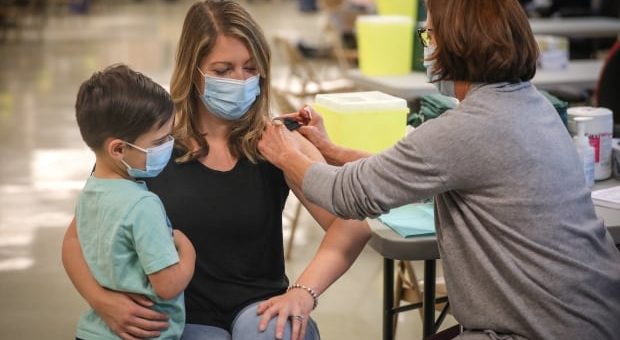
A daycare operator in Regina says the current flu season has been even worse than when “we were in full COVID.”
“People were isolating at that time and whatnot, but now everyone is back,” said Megan Schmidt, director of First Years Learning Center.
“It just seems that everybody is catching everything. I don’t think there’s anybody that hasn’t been touched by the flu,” Schmidt said.
Pandemic precautions prevented the spread of COVID and respiratory viruses for almost three years. Influenza levels were exceptionally low nationally until early 2022, and respiratory syncytial virus (RSV) infection rates were close to zero for months.
But now Canada is facing a triple virus threat as COVID-19, flu and RSV continue to spread.
Prairie provinces have the worst rates of positive flu tests, according to the Public Health Agency of Canada’s FluWatch report from Nov. 6 to Nov. 12. Almost a third of tests came back positive (28 per cent).
Adam Ogieglo, a family physician in Saskatoon, is not surprised by the high positivity rates.
“I think over the last two or three weeks essentially every swab I’ve done apart from one has come back positive for influenza A. So we are definitely seeing those stats born out in real-time in our clinic.”
He said people seeking help at the urgent clinic care are waiting four or five hours to see a physician or being turned away altogether toward the end of the day.
“People are having trouble accessing care and we’re just bombarded with illness,” he said.
Dr. Lynora Saxinger, an infectious diseases specialist at the University of Alberta, says western provinces normally get an earlier flu season than the rest of Canada because school starts sooner and the climate is drier.
“Once it gets introduced into a region, they start to experience their epidemic,” she said.
But since many people managed to avoid getting sick the past few years, Saxinger and other experts say people’s immunity has waned.
“What we have is a population that really doesn’t have much of an immunity from partial exposure to influenza or partial immunity from more recent vaccination, so it’s a bit more of an aggressive uptick because people are that much more susceptible,” Saxinger said.
Youngsters hit hardest
Children four years old and younger currently have the highest rates of hospitalization due to influenza, according to PHAC.
So far, Schmidt says, no children at her daycare have been hospitalized this year because of the flu.
“I just hope that continues,” she said. “We just urge parents to try to let them sleep in if they need to, or we try to give them maybe an extra long nap here if they need it because we just have to avoid the hospital.”
Emergency room wait times, especially in children’s hospitals, are increasing across the country.
In Saskatchewan, 16 people were admitted to hospital because of influenza from Oct. 30 to Nov. 5, according to the province’s report on respiratory illnesses. Four were admitted to the intensive care unit.
The majority of influenza hospitalizations and ICU admissions are among those 19 and younger and 60 years and older, according to the province.

Low vaccination rates
Saskatchewan, Alberta and Manitoba are all reporting lower than normal flu shot uptake.
Less than 18 per cent of Albertans have their flu shot, according to provincial data.
Saxinger says people got out of the habit of getting their flu shots during the COVID-19 pandemic.
“I think it’s flown beneath the radar a little too much and we’re behind on the vaccination,” she said.
Canada’s Prairie region is an early hotspot for flu, with test positivity hitting 28 per cent. Experts blame low vaccination rates and years of pandemic protections that left populations with lower immunity, and children may be the most at risk.
In other years, 50 to 60 per cent of the population would have their flu shots, according to Saxinger.
Saskatchewan’s influenza immunization campaign was launched on Oct. 11. Fifteen per cent of the population received the influenza vaccine as of Nov. 5, according to the province’s report.
That’s a 28 per cent decrease in coverage compared with the same time last year, the report said.
Calls for more measures
The Prairie provinces, like others, haven’t had provincial health mandates in months. Mask use hasn’t been mandatory in Saskatchewan since late February, but the rapid surge of flu and RSV has renewed calls from some frontline workers to reinstate mask mandates to alleviate the strain on the healthcare system.
The top doctors in British Columbia, Ontario, Quebec, Alberta, Manitoba, Saskatchewan, Prince Edward Island and Newfoundland and Labrador have all said now is not the time to reinstate mask mandates, but continue to recommend masks to slow viral spread.
Ogieglo encourages people to wear masks indoors, stay home when sick and get their flu shot and COVID-19 booster
“If you walk into our clinic and see the lineup that is stretching around the building [waiting] to be seen, then I think it makes sense that maybe we need to act together to protect the integrity of our health-care system,” he said.












